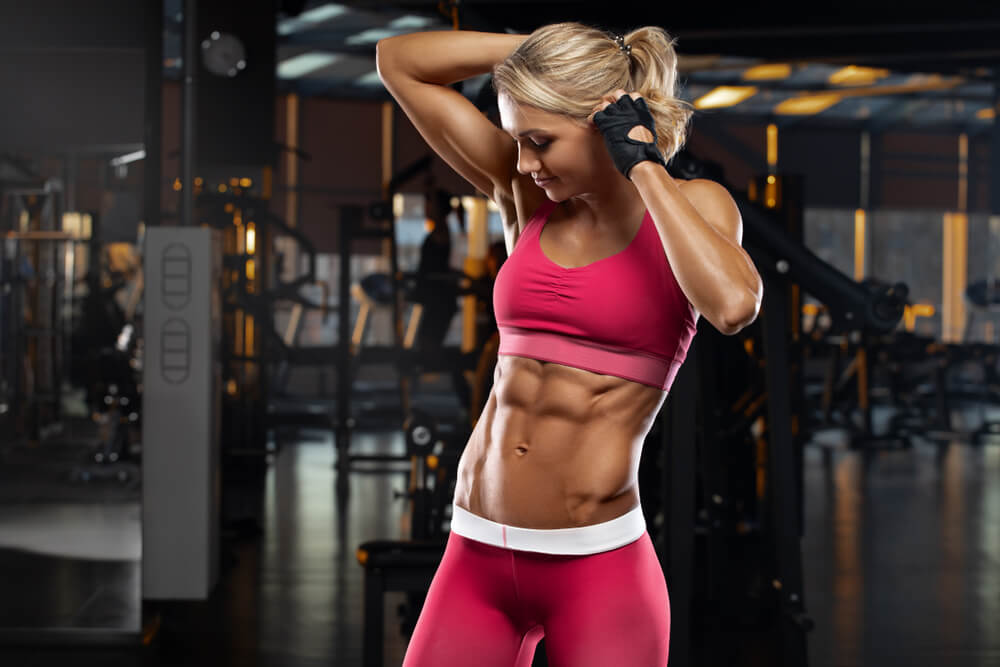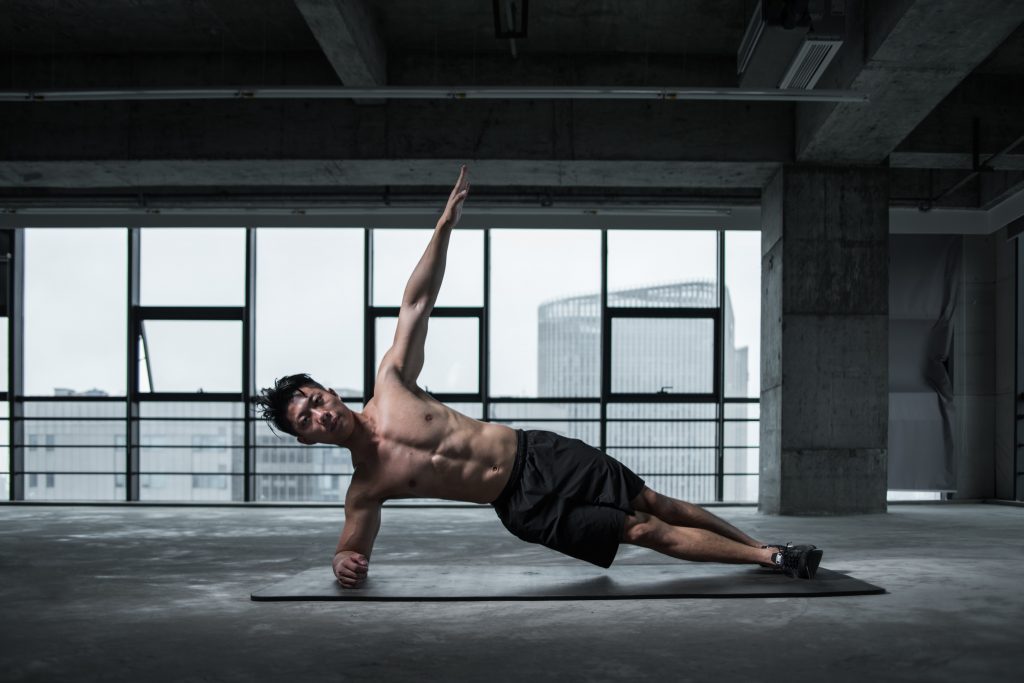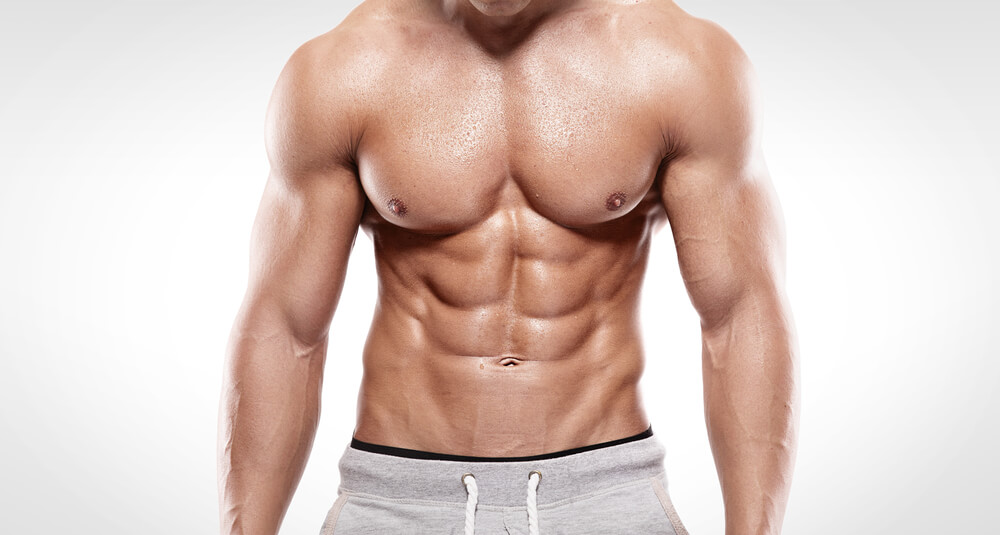
With a name like “the core” it’s quite clear how important this part of the body is.
You need your core for absolutely everything that you do.
And if you’re a gym goer, a strong core is going to make your life on the gym floor so much easier.
Whether you’ve noticed that you’re looking a little hunched (probably from hours spent slumped over your desk), perhaps your lower back feels like it’s always sore, or maybe you’re looking for a way to improve your lifting at the gym – strengthening your core can actually help to improve these things and make your day-to-day life a whole heap easier.
Building strength in your core muscles can (and should) be done at any level of fitness, so whether you’re just starting out or you’re already a beast in the gym, we’ve got some great exercises you can start incorporating into your routine. Not only will you build a strong core, but you might also end up rocking a 6-pack too.
But, before we dive right into these core-strengthening exercises – let’s talk a little more about what the core actually is and why we need it.
So, what makes up the core?
Your core, also referred to as the trunk, is much more than just your abs. That is a common misconception. But one way to think of your core is as the central hub of your body.
It is essentially all of the muscles in your back, your pelvis and of course, your abdominal area. Some of the major muscles of the area include:
- Traverse abdominis: this muscle is used to stabilise the pelvis, wrapping around the front and side of the trunk.
- Rectus abdominis: sometimes called the “six-pack” muscle, this is the muscle you use when you bend forward.
- Internal & External Obliques: the obliques allow your trunk to bend and rotate, extending diagonally from the ribs to the pelvis.
- Multifidus: this is a back muscle that helps to support the spine.
- Erector spinae: this is the back muscle that actually helps you stand up straight after bending, helps you to bend sideways and also allows you to rotate your head.
In addition to these muscles, there are some other ones that make up the core, including:
- Glutes
- Pelvic floor
- Glutes
- Diaphragm
And in addition to those, the muscles that attach to the pelvis area, like the hip flexors, hamstrings and hip abductors all work together with the core.
Why do we need a strong core?
Ok, so from the moment you wake up each day, you’re going to be using your core. Actually, to be fair, you’ll be using your core even when you’re asleep.
Your core is the central point of your body that connects your upper and lower body muscles, so basically anything you do with those parts of the body actually originates from or moves through the core.
When your core muscles are weak or not as strong as they could be, it can impact how you move, often limiting your mobility and the power and ease with which you do things.
Strong core muscles can help to improve your balance and stability which is important at all times, but especially as you age.
Some of the things you may not realise your core helps with include:
-
Your posture
We mentioned this earlier, but we’re going to talk about it again, because now, more than ever, people are suffering from poor posture. It’s no surprise as many people work in offices and at desks for 8 hours a day (at least). Strong muscles can help you stop slouching, and also reduce the wear, tear and pressure on your spine.
-
Daily activities
The simplest tasks still require use of your core. Even something as simple as standing up, picking up something off the floor, getting dressed, putting on your shoes and even doing the dishes. Your core is being used in each of these tasks and when it’s strong, it makes all of these things so much easier to do.
-
Make your job easier
If you have a physical laborious job, perhaps you need to lift things regularly, you’re climbing up and down ladders, and handling heavy things. Without a strong core to support you, you can end up damaging other muscles, particularly those in the back that may take on some of the load if your core is slacking.
-
Improves your sporting prowess
Every single sport will use your core, however, there are some that engage it significantly more. Sports like swimming, golf, tennis, baseball, kayaking and any that involve rotational movements are all made better and easier when those core muscles are strong. A strong core can also make it easier to avoid sporting injuries.
-
Helps you build up muscles in other areas
Sometimes, no matter how hard you try, it can be hard to build up the muscle in some areas of your body, and a weak core might have something to do with it. A weak core can stop you from being able to perform exercises that might otherwise build up the muscles you’re targeting.

Exercises to engage and strengthen the core
Alright, now it’s time to get into it. It doesn’t matter your level of fitness when it comes to getting started on working out the core. In fact, a lot of these exercises are more simple than you might expect, and super effective.
So, whether you’re a beginner, part way or well and truly in your fitness journey, let us tell you some of the best core exercises to build up strength and start engaging that core.
Core strengthening exercises for beginners
1. Bridge
How to do it:
You don’t need any equipment for this one – all you need to do is lie on the floor – if you have an exercise mat lie on that for some added comfort.
While you’re lying on your back, bend your knees so that your feet are flat on the ground.
By pushing through your heels you lift your hips and glutes upwards as far as you go. Effectively you should end up in a diagonal line from your knees down to your mid back.
Pause for a moment in this position before lowering back down to the starting position. Then repeat.
What it does:
The bridge is a simple yet highly effective exercise that you may not realise helps to strengthen the core. Your glutes are activated as you lift your hips off the floor and this helps your core by adding strength and support to your glutes and lower back. Strong glutes equals a strong lower back which means a happy core as well.
2. Supine toe taps
How to do it:
Like the bridge, you don’t need equipment for this one, other than a mat for added comfort.
Lie on the floor on your back and lift your legs with your knees bent at 90 degrees. You might look like you’re sitting in a chair only while you’re lying on your back.
While you’re in this position, keep your hands at your sides with your palms facing down.
From here, you want to lower one foot and gently tap the floor, while keeping the other leg still and your back flat.
Raise the leg you’ve lowered back to the starting position and then repeat the exercise with the other leg.
What it does:
This exercise is actually a pilates move that works your glutes, legs, hips, all while engaging your core.
It’s also low impact which means that you’re not putting unnecessary strain on the body.
3. Bird Dog Crunches
How to do it:
Again, other than a mat, you don’t need any equipment for this one.
Start off on all fours so that your legs and knees are below your hips and your hands are below your shoulders.
Now, you want to do two things at once, you want to lift and straighten one leg, let’s say your left leg, and extend it so that it is straight behind you and level with your hip. At the same time, you’ll be lifting and extending your opposite arm, so in this case, your right arm.
The aim is to have a straight line from the tips of your extended hand to the toes of the extended leg. You don’t want to arch your back.
After a brief pause, you then want to lower your leg and arm to the starting position and repeat on the alternate arm and leg.
What it does:
This one does take a little getting used to, but over time it will help to improve your balance, stability and coordination. This exercise engages both the back and abdominal muscles, strengthening that key core area.
Core building exercises for intermediate fitness levels
1. Forearm plank rocks
How to do it:
So, if you’re a bit of a way into your fitness journey, you are probably pretty comfortable with standard planks (which are great exercises for the core).
This exercise is a step up of a normal plank but starts in a similar way.
Start off in a forearm plank position. Your forearms should be flat on the floor with your elbows directly underneath your shoulders. You legs should be extended behind you.
Lift yourself off the ground so your forearms are supporting you. IN this position you want to keep your tailbone tucked.
Now, for the rocking. You want to move your body forward, in a gentle rock. Your body should move forward a couple of inches so that your shoulders are moving forward towards your shoulders.
Pause for a moment, then rock back to your starting position.
What it does:
Keeping your core and glutes engaged in this exercise is no joke. This exercise engages your most of the major muscles of the core area, including the obliques, the traverse abdominis and rectus abdominis, which can also help to support your back.
2. Jack knife
How to do it:
For this one, you don’t need any equipment except a mat if you want that added comfort.
Start by lying on the ground face up.
Extend your arms so they are above your head on the ground, and your legs straight in front of you.
Now, you want to lift your legs off the ground, while keeping them straight and move them towards the middle of your body. At the same time you lift your arms, head and upper back off the ground towards the middle of the body.
The aim is to move your feet and hands towards each other so they meet in the middle.
You then want to return to your starting position, but don’t just flop down, you want to lower slowly, keeping your core and abs engaged the whole time.
What it does:
This exercise isn’t easy, you need to engage lots of muscles outside of the core including your thighs and glutes. The best part of this exercise (obviously besides when you’ve finished doing it), is that it engages all of your core muscles, and is a good solid workout for the whole core.
3. Mountain climbers
How to do it:
For mountain climbers, you need to start in a plank position, but up on your hands rather than your forearms, because you need that extra height underneath your body.
Make sure your hands are below your shoulders and keep your core tight.
Keep your hips down and your back straight as you lift your right knee toward your chest.
Return your leg back to the starting position and then lift the opposite leg towards your chest.
You want to keep alternating legs.
Go as fast or as slow as you feel comfortable with.
What it does:
Mountain climbers work out your core and helps to improve your balance at the same time. It requires a bit of coordination. In addition to engaging and strengthening your core, mountain climbers also help to build strength in the shoulders, hamstrings, and quads, which help support your core as well.
Advanced core exercises
1. Barbell roll out
How to do it:
You’re going to need some equipment for this one.
You want to load a barbell with some weight plates – you can use 5kg plates on each side.
Once your barbell is loaded, get down on your knees behind it so that you can position your hands shoulder-width apart and grip the barbell. The barbell should be around 15-25cm in front of you as you do this.
Once you have your grip, you want to slowly roll the bar forwards so that your body is slowly lowered to the floor as your arms stretch in front of you.
Once you’re as low as you can go, pause, then you want to reverse the movement.
The trick with this one is that obviously the further out you go, the more strength it takes, however, you don’t wan to go so far that it makes your hips sag. You want to be in control of your body.
What it does:
In this move, all of the muscles that make up your core are engaged. This one requires a lot of effort and skill. It also helps to improve stability and strength.
2. Hanging knee/leg raises
How to do it:
You need something you can hang from for this one – like a pull up bar.
To start you want to be in a hanging from the bar with your hands, keeping your body straight.
You then want to bend your knees, and using your lower ab muscles, raise your legs toward your chest. Aim to raise your knees/legs until your thighs are parallel to the ground.
Pause for a moment. Then lower your legs to the starting position, but don’t just drop your legs, keep your abs engaged as you lower.
What it does:
This one is quite the workout for your lower abs. But it also helps to strength the stabilising muscles of your core. In addition to that, it’s great for improving your grip and strengthening your forearms.
3. L-sits
How to do it:
This one is deceptive. It might look simple, but it requires stability and strength.
You don’t need equipment for this one. You just need to sit up straight on the ground with your legs extended straight in front of you.
Your arms should be by your sides, hands palm down on the ground with your fingers facing forward.
You want to push through your arms until they are extended straight, and you are lifting yourself off the ground. Your legs and glutes should be clean off the ground and held parallel to the ground.
You only need to lift yourself up an inch or so, and hold.
Then lower yourself back down.
What it does:
You might think this one is about the arms, and while it does strengthen them, it’ also helps engage your core muscles, your thighs and quads as you keep your legs straight while you’re lifting yourself off the ground. It’s definitely harder than it looks.
Workout Your Core at Rec Xpress
Alright, now that you’ve got some effective core exercises for every level of fitness, all that’s left to do is show them off in the gym.
Why not do that at one our 6 gyms around Melbourne’s south east suburbs. We’ve got a team of fitness experts who can help you strengthen your core no matter your fitness level at each of our gyms in Bentleigh, Cheltenham, Clayton, East Brighton, Oakleigh, and Ormond.
Memberships start from just $12.95 a week, and with no contract and 24/7 access to our gyms, it couldn’t be easier to strengthen that core.

